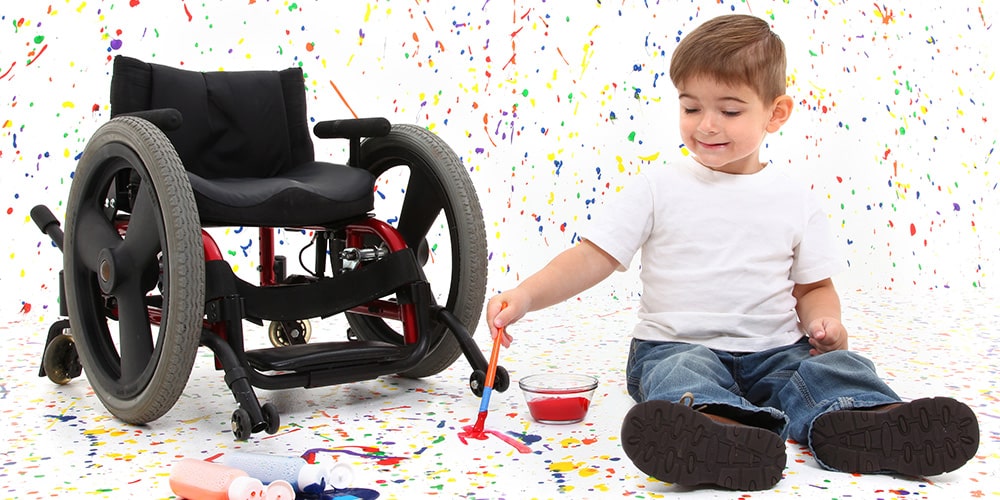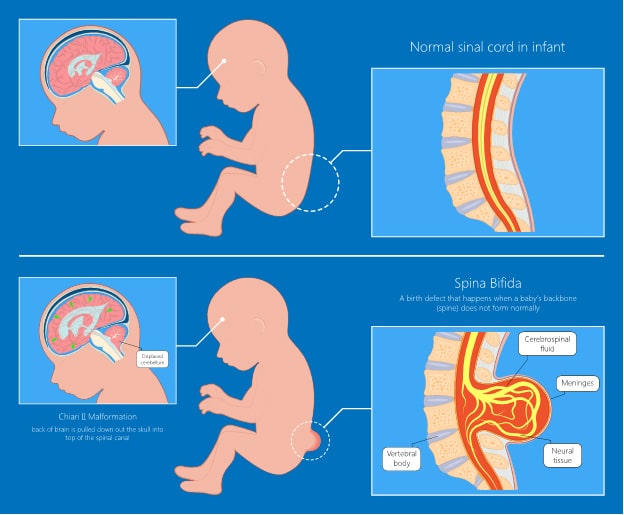
Spina Bifida Physiotherapy Management - What You Need to Know
Thursday, September 24, 2020
Spina bifida is a complicated birth defect that affects the spinal cord and, sometimes, its surrounding nerve endings. As you can imagine, spina bifida can cause a plethora of health problems, both physical and neurological.
Here, we're going deeper into what spina bifida is, its causes and symptoms, as well as how physiotherapy can help in its treatment.
What is Spina Bifida?
Spina bifida occurs due to a birth defect where the spinal cord doesn't close completely during the early stages of the pregnancy. When this happens, the bones of the spine are unable to effectively protect the spinal cord.
The result often causes damage to the spinal cord itself or damage to the nerves surrounding the spinal cord.

Spina Bifida Causes
Unfortunately, the causes of spina bifida are mostly unknown. We know that spina bifida occurs in the womb during pregnancy as a birth defect although it's unclear which aspects of genetics or which environmental factors might be at play.
Spina Bifida Symptoms
Depending on the size and location of the opening in the spinal cord, spina bifida causes a range of symptoms. Generally, spina bifida presents itself as physical and/or mental disabilities ranging from mild to severe.
Some common symptoms of spina bifida include:
- Inability to move the lower body due to paralysis and weakness of the spinal cord or its surrounding nerve endings
- Poor bowel and bladder control
- Skin issues
- Orthopaedic issues
- Learning disabilities
- Attention problems
- Other neurological complications
Since messages from the brain use the spinal cord to send signals to all the nerves in our body, spina bifida can affect pretty much every process controlled by our nervous system, depending on which area of the spinal cord was affected.
Spina Bifida Classifications
There are a few different kinds of spina bifida which cause varying symptoms.
- Occult Spinal Dysraphism (OSD)
- Usually causes a dimple and red spots on the lower back, along with tufts of hair or small lumps
- Only a small spinal defect which causes minor issues like skin conditions and issues with the tissue just below the skin
- If nerves were affected, OSD can also affect growth in children
- Spina Bifida Occulta (SBO)
- Not visible on the back and often referred to as “hidden” spina bifida
- Caused by a small gap in a few of the spinal vertebrae
- Occurs in about 15% of the population causing no symptoms
- However, if the nerves were affected, SBO can affect neurological symptoms
- Can cause what's called a “tethered cord” if the spinal cord is pulled during growth
- Meningocele
- Occurs when the protective coating of the spinal cord, called meninges, protrude through an open part of the spine
- Nerve damage is uncommon
- Minor disabilities may be present
- Myelomeningocele
- Most severe classification of spina bifida, also known as myelodysplasia
- Occurs when the meninges and spinal nerves protrude through an open part of the spine
- Nerve damage and severe disabilities are common
- 90% of children with myelomeningocele also have hydrocephalus, or excess fluid in the brain with often requires surgery
- Issues with motor control, learning, and mobility may be present
Spina Bifida Physiotherapy Management
Physiotherapy might not be the first treatment method you think of when it comes to spina bifida, but, in fact, physiotherapist management is an important health care partner for patients with spina bifida, as well as their family members and carers.
Physiotherapists can help children and adults with spina bifida by helping them gain and maintain mobility and overall, to function at their best throughout every stage of life
Physiotherapists will also work alongside your other healthcare providers such as orthopedists and occupational therapists for a more holistic treatment plan that expands into every aspect of your life.
Spina Bifida Physiotherapy Assessment
When someone with spina bifida first begins working with a physiotherapist, an assessment might include:
- Asking about birth and developmental history to help get an understanding of where they might fall on a normal development progression
- When could they hold they head up, roll over, crawl, or walk?
- Asking about general health
- Have they been sick or in hospital? When was their last GP visit?
- Addressing parental concerns and about what the parents hope to accomplish in the treatment plan
- A physical examination to measure their height and weight, observe movements, balance, and coordination, and complete a tactile exam of muscle strength, flexibility, and tone
- A motor skills examination to test motor development while sitting, crawling, walking, and hand use. The exam might also look at vision, language skills, and other developmental milestones.
Spina Bifida Physiotherapy Treatment
Once your physio has completed an assessment, a customised treatment plan can begin either at a clinic or on the go, bringing mobile physio services to you at home or at school.
Some physiotherapy treatment plans for spina bifida include:
- Infant positioning needs
- Parent and family education during infancy
- Early intervention to provide physiotherapy techniques to encourage the healthy development of strength, balance, and motor skills while teaching parents to incorporate these techniques into their daily lives
- School-based physiotherapy to work with children with spina bifida on school-related motor skills and tools to help with any neurological deficiencies
- Providing the appropriate equipment to help children and adults with spina bifida including braces, walkers, and wheelchairs
- Prevention of other possible issues including obesity through the encouragement of fitness-based activities to promote long-term health and wellbeing
Again, your physiotherapist will often work in tandem with other healthcare providers to take a holistic approach to spina bifida treatment. And, just as important as working with the patient is educating the parents and carers as well -- an important part of the process that physiotherapists can also provide.
How to Find a Spina Bifida Physiotherapist
When it comes to finding a physiotherapist to help treat spina bifida, there are few things to keep in mind.
- Choose a physio with experience in paediatrics or developmental disorders.
- Go with a board-certified physio that you know you can trust.
- Make sure the physio you choose is comfortable working with other healthcare professionals to be sure all of your child's doctors are on the same page.
- Get recommendations from friends and family to help make your decision.
- Start with a physiotherapy consultation to see what they can offer.
- Go to a clinic that's convenient for you, whether it's on your way home from picking up the kids at school or they offer mobile services that come to you.
At Physio Inq we offer Paediatric Physiotherapy Mobile services right throughout Australia.
Taking these steps will make the decision-making process much more manageable and can help you feel confident in your final choice.
Looking to get started on spina bifida physiotherapy treatment for your infant or child? Book an appointment at one of our convenient Physio Inq locations throughout Australia or take advantage of our amazing Paediatric Physiotherapy Mobile services can come to you. We're here to help!
This article was originally written by Jonathan Moody from Physio Inq

